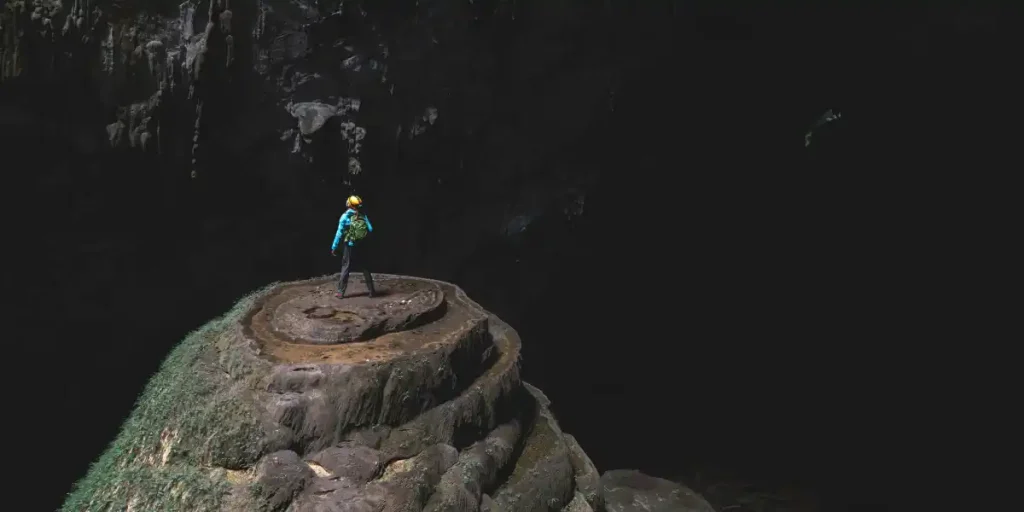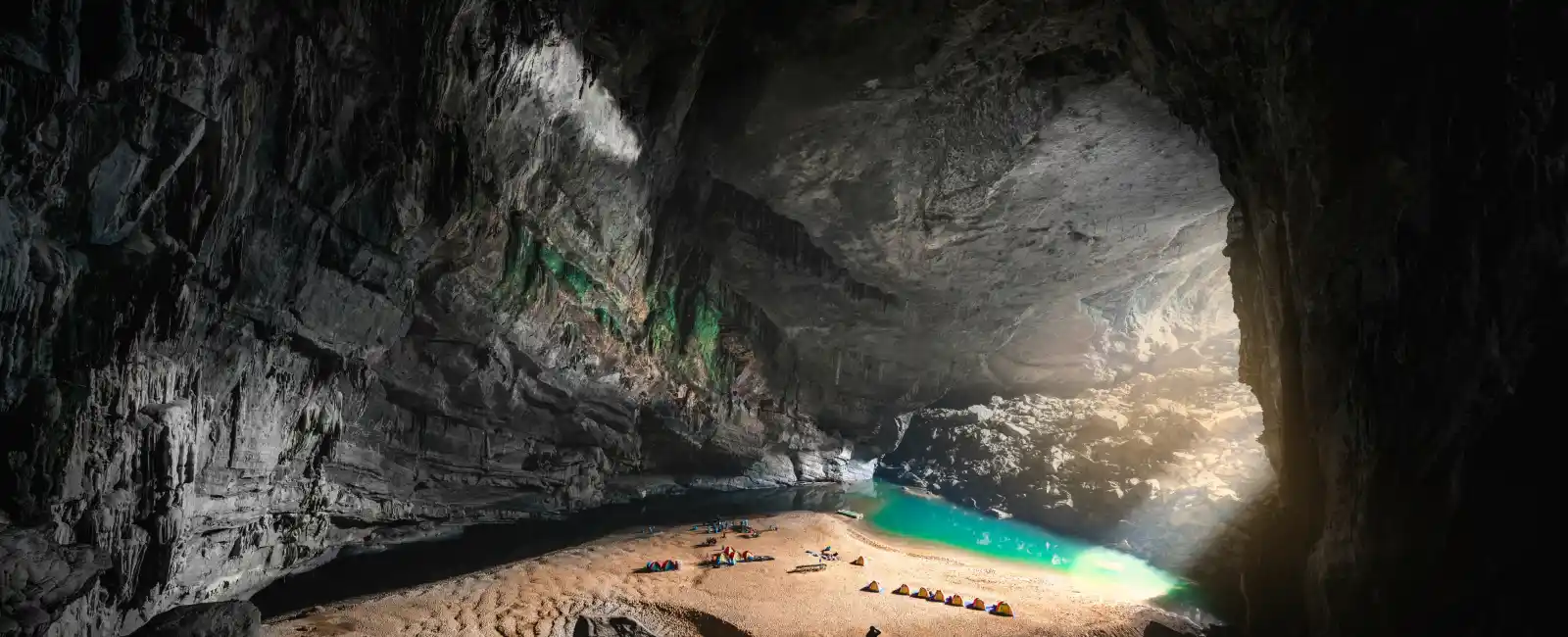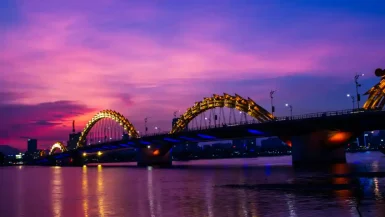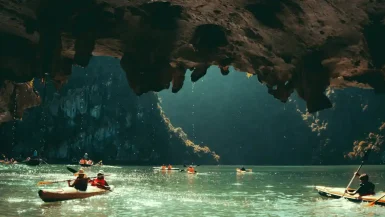Quang Binh, a province in Central Vietnam, boasts natural beauty and rich history. Nestled between the East Sea and the Annamite Mountains, Quang Binh offers a diverse range of landscapes and activities. From stunning caves and pristine beaches to historical sites and vibrant local culture, Quang Binh captivates travelers seeking both adventure and relaxation. The province’s unique geographical location provides a stunning contrast between rugged mountains and serene coastlines. Quang Binh’s lush forests and rivers add to its scenic charm, offering countless opportunities for outdoor enthusiasts.
In addition to its natural attractions, Quang Binh’s rich cultural heritage is deeply rooted in its history. The local cuisine, traditions, and festivals reflect the vibrant spirit of the people. Travelers can immerse themselves in the daily life of Quang Binh’s residents, experiencing firsthand their warmth and hospitality. Whether exploring ancient ruins, diving into crystal-clear waters, or trekking through dense jungles, visitors will find that Quang Binh has something to offer everyone. The province’s commitment to preserving its natural and cultural treasures ensures that future generations can also enjoy its beauty. Quang Binh stands out as a must-visit destination for anyone exploring Vietnam.
Spectacular Caves: Nature’s Masterpieces
Quang Binh’s caves are its most famous attractions. Phong Nha-Ke Bang National Park, a UNESCO World Heritage site, houses some of the world’s most magnificent caves. Son Doong Cave, the largest cave on the planet, tops the list. Discovered in 2009, Son Doong features a vast interior, underground rivers, and a unique ecosystem. Adventurers embark on multi-day expeditions to explore its depths, requiring physical stamina and a spirit of adventure.
Hang En, the world’s third-largest cave, also resides in Phong Nha-Ke Bang. Visitors marvel at its grand chambers and the river running through it. Camping inside the cave adds a sense of wonder and excitement to the experience. Additionally, Phong Nha Cave and Paradise Cave offer more accessible yet equally breathtaking options. Boat rides along the underground river in Phong Nha Cave reveal stunning rock formations, while Paradise Cave’s immense chambers and stalactites leave visitors in awe.
Not to be overlooked, Tu Lan Cave System offers an adventurous experience with its series of wet and dry caves. This cave system, located outside the main Phong Nha area, involves swimming, wading, and trekking through the jungle. The challenging journey rewards visitors with stunning cave formations and untouched natural beauty. Each cave within the Tu Lan system has its own unique characteristics, making the exploration a multifaceted adventure.
The Dark Cave, also part of Phong Nha-Ke Bang, provides a different kind of adventure with its combination of caving and ziplining. Visitors start with a thrilling zipline ride across the river, followed by a guided tour through the cave’s narrow passages and mud baths. This interactive experience, combined with the stunning natural surroundings, offers a fun and memorable way to explore Quang Binh’s subterranean wonders.

Pristine Beaches: Coastal Gems
Quang Binh’s coastline stretches over 116 kilometers, offering beautiful beaches and serene bays. Nhat Le Beach, near Dong Hoi City, is a favorite among locals and tourists alike. The beach’s white sand and clear waters provide the perfect backdrop for relaxation and water activities. Beachfront cafes and seafood restaurants line the shore, offering delicious local dishes and refreshing drinks.
Further south, Da Nhay Beach features unique rock formations and quieter surroundings. The name “Da Nhay” means “jumping rocks,” referring to the wave-carved stones scattered along the shore. This beach is ideal for photography and exploring tide pools teeming with marine life. Quang Phu Sand Dunes, located near Nhat Le Beach, offer another unique coastal attraction. Visitors can enjoy sandboarding or simply marvel at the vast, shifting dunes.
Hidden Gems: Lesser-Known Treasures
Beyond its well-known attractions, Quang Binh harbors many hidden gems waiting to be discovered. The idyllic village of Phong Nha, set against the backdrop of lush mountains and rice paddies, offers a peaceful escape from bustling city life. Here, visitors can interact with friendly locals, learn about traditional farming practices, and enjoy home-cooked meals at family-run guesthouses. The surrounding countryside, with its quiet trails and scenic viewpoints, invites exploration and offers countless photo opportunities.
Not far from Phong Nha lies the serene Bong Lai Valley, an off-the-beaten-path destination perfect for those seeking tranquility and natural beauty. The valley’s rolling hills, dotted with farms and grazing water buffalo, create a picturesque landscape reminiscent of a pastoral painting. Travelers can visit local farms, sample fresh produce, and even try their hand at traditional Vietnamese farming techniques. The valley’s meandering rivers and streams provide ideal spots for picnicking and cooling off on hot days.
Quang Binh’s Wildlife: A Biodiverse Haven
Quang Binh’s diverse ecosystems support a wide array of wildlife, making it a paradise for nature lovers. Phong Nha-Ke Bang National Park, with its dense forests and rugged terrain, is home to numerous plant and animal species. Birdwatchers can spot rare and colorful birds, such as the chestnut-necklaced partridge and the red-collared woodpecker. The park’s rivers and streams are inhabited by various fish and amphibians, adding to its ecological richness.
The region also provides habitat for several endangered species. The elusive Saola, also known as the “Asian unicorn,” resides in the remote areas of the Annamite Mountains. Although sightings are rare, the presence of this unique animal underscores the importance of conservation efforts in Quang Binh. The park’s rangers and local conservationists work tirelessly to protect these vulnerable species and their habitats. Visitors can support these efforts by participating in eco-tours and learning about the region’s biodiversity.
Rich History: Echoes of the Past
Quang Binh’s historical sites reflect its long and storied past. The province played a significant role during the Vietnam War, with remnants of that era visible in various locations. The DMZ (Demilitarized Zone) and Vinh Moc Tunnels, just north of Quang Binh, offer insight into the war’s impact. The tunnels, used by local residents to shelter from bombings, reveal the resilience and ingenuity of the Vietnamese people.
Within Quang Binh, Dong Hoi Citadel stands as a testament to its historical significance. Built in the 19th century, the citadel once served as a military stronghold. Although much of it was destroyed during the war, restoration efforts have preserved its gates and walls. Exploring the citadel provides a glimpse into Quang Binh’s strategic importance throughout history. Additionally, the Quang Binh Museum, located nearby, houses artifacts and exhibits that detail the region’s historical events and cultural heritage. Visitors can learn about Quang Binh’s role in the Nguyen Dynasty and its contributions to Vietnam’s resistance movements.
Not far from the citadel, the Tam Toa Church ruins offer another poignant reminder of the war. This Catholic church, heavily bombed during the Vietnam War, stands as a silent witness to the past conflicts. Its remaining bell tower and walls evoke a sense of loss and resilience. Exploring these historical sites provides a deeper understanding of Quang Binh’s turbulent history and the enduring spirit of its people.
The Hoang Phuc Pagoda, one of the oldest pagodas in Central Vietnam, adds a spiritual dimension to Quang Binh’s historical landscape. Founded over 700 years ago, the pagoda attracts pilgrims and tourists with its serene ambiance and historical significance. Renovated and preserved, the pagoda serves as a center for Buddhist worship and cultural activities. Visiting these historical landmarks offers a comprehensive view of Quang Binh’s past, blending elements of war, religion, and cultural heritage.
Vibrant Local Culture: A Tapestry of Traditions
Quang Binh’s culture reflects a blend of influences from various ethnic groups. The Bru-Van Kieu people, an ethnic minority in the region, maintain their unique customs and traditions. Visitors can experience their vibrant culture through traditional music, dance, and handicrafts. Local markets, such as Dong Hoi Market, offer a colorful array of goods, from fresh produce and seafood to handmade crafts and textiles.
Festivals in Quang Binh provide another window into its cultural richness. The annual Boat Racing Festival on the Nhat Le River draws crowds with its exciting races and festive atmosphere. The Keo Pagoda Festival, held in Le Thuy District, celebrates Buddhist traditions with processions, rituals, and cultural performances. Participating in these festivals allows travelers to connect with the local community and gain deeper insight into their way of life.
Outdoor Adventures: Thrills and Challenges
Quang Binh’s diverse landscapes make it a paradise for outdoor enthusiasts. Beyond its famous caves, the province offers numerous opportunities for trekking, kayaking, and rock climbing. The Phong Nha-Ke Bang National Park features several trekking routes, ranging from easy walks to challenging hikes. The Nuoc Mooc Eco Trail, for instance, leads through lush forests and across crystal-clear streams, ending at a tranquil swimming spot.
Kayaking on the Chay River provides a different perspective of Quang Binh’s natural beauty. Paddling through the river’s calm waters, surrounded by towering limestone cliffs and verdant vegetation, is both peaceful and exhilarating. For rock climbing enthusiasts, the cliffs around the Tu Lan Cave System present a challenging and rewarding experience. These activities allow visitors to immerse themselves in Quang Binh’s stunning landscapes while testing their physical limits.
Culinary Delights: Flavors of Quang Binh
Quang Binh’s cuisine reflects its coastal location and agricultural abundance. Seafood dishes dominate local menus, with fresh fish, shrimp, and squid prepared in various ways. One must-try dish is “Banh Xeo,” a savory pancake filled with shrimp, pork, and bean sprouts, served with fresh herbs and dipping sauce. “Banh Khoai,” a similar dish but smaller and thicker, offers another delicious option.
Local specialties also include “Chao Canh,” a thick noodle soup with a rich, flavorful broth, often topped with fresh herbs and lime. Another popular dish is “Nem Lui,” grilled pork skewers served with rice paper, fresh vegetables, and dipping sauce. Street food stalls and local restaurants provide ample opportunities to sample these culinary delights. The freshness and variety of Quang Binh’s food will leave a lasting impression on any visitor.
Sustainable Tourism: Protecting Natural Wonders
As Quang Binh’s popularity as a tourist destination grows, so does the need for sustainable tourism practices. Efforts to preserve the natural environment and cultural heritage are crucial. Phong Nha-Ke Bang National Park implements strict regulations to protect its fragile ecosystems. Guided tours and eco-friendly practices help minimize the impact of tourism on the caves and surrounding areas.
Local communities also play a vital role in sustainable tourism. Initiatives that involve local residents in tourism activities ensure that economic benefits are shared. Community-based tourism programs, such as homestays and village tours, provide authentic experiences while supporting local livelihoods. Travelers can contribute to these efforts by choosing responsible tour operators and respecting the environment and local culture.
Getting There and Around: Practical Information
Quang Binh is accessible by air, train, and road. Dong Hoi Airport offers flights to and from major cities like Hanoi and Ho Chi Minh City. The Reunification Express train, which runs from north to south Vietnam, stops in Dong Hoi, providing a scenic and convenient travel option. Buses and private cars also connect Quang Binh with neighboring provinces and cities.
Within Quang Binh, motorbikes and bicycles are popular modes of transportation. Renting a motorbike allows for greater flexibility in exploring the region. However, for those who prefer guided tours, many local operators offer excursions to the main attractions. Dong Hoi City serves as a convenient base for exploring Quang Binh, with a range of accommodations from budget hostels to luxury hotels.
Navigating the city and surrounding areas is relatively easy due to well-maintained roads and clear signage. The friendly locals are always willing to help with directions and tips. For a more leisurely pace, cycling tours are available, offering a close-up view of the scenic landscapes and local life. Taxis and ride-hailing services like Grab provide another reliable option for short trips within the city. For those looking to explore the coastal areas, boat tours are available, offering a unique perspective of Quang Binh’s shoreline. Travel agencies in Dong Hoi can assist with planning and booking various transportation options, ensuring a hassle-free experience. With these diverse transportation choices, visitors can easily tailor their travel plans to suit their preferences and schedules.
Conclusion: The Timeless Charm of Quang Binh
Quang Binh, with its natural wonders, rich history, and vibrant culture, offers a unique and unforgettable travel experience. Whether exploring the awe-inspiring caves, relaxing on pristine beaches, or immersing in local traditions, visitors will find countless reasons to fall in love with this enchanting province. As sustainable tourism practices continue to protect Quang Binh’s treasures, future generations of travelers will also have the opportunity to discover its timeless charm. So, pack your bags and embark on a journey to Quang Binh, where adventure and serenity await.



